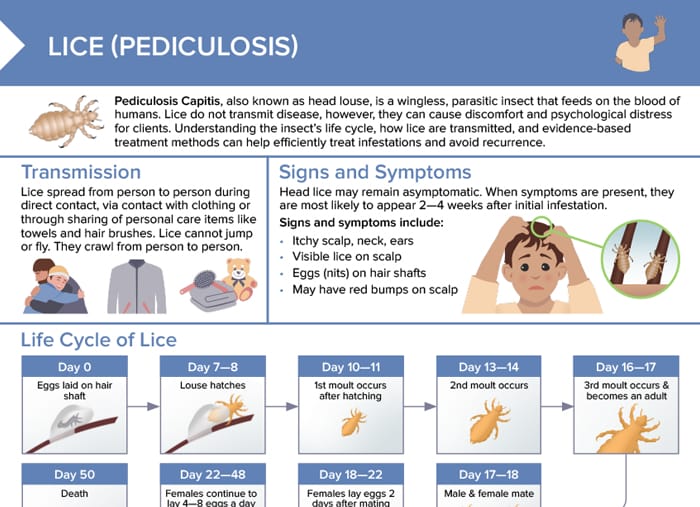What is pediculosis capitis?
Pediculosis capitis is the biological name of the head louse, a wingless, parasitic insect that feeds on the blood of humans.
Lice do not transmit disease, however, they can cause discomfort and psychological distress for clients. Understanding the insect’s life cycle, how lice are transmitted, and evidence-based treatment methods can help efficiently treat infestations and avoid recurrence.
Picture of a head louse and egg

Illustration of an adult head louse and a louse egg (nit)
Image: “Head louse” by BruceBlaus. License: CC BY-SA 4.0Life cycle of head lice
- Day 0: Eggs are laid on hair shafts.
- Day 7–8: Lice hatch.
- Day 10–11: first moult after hatching
- Day 13–14: second moult
- Day 16–17: third moult; louse becomes an adult
- Day 17–18: Male and female lice mate.
- Day 18–22: Females lay eggs 2 days after mating.
- Day 22–48: Females continue to lay 4–8 eggs a day.
- Day 50: death
How to check for head lice: signs and symptoms
Head lice may remain asymptomatic. When symptoms are present, they are most likely to appear 2–4 weeks after initial infestation:
- Itchy scalp, neck, ears
- Visible lice on scalp
- Eggs (nits) on hair shafts
- May have red bumps on scalp
Lice vs dandruff
Both a head lice infestation and dandruff can cause itching, even though the itching caused by dandruff is usually much milder. You can differentiate dandruff and lice by looking at the specific appearance: dandruff is flakey and typically white or yellowish. It is dry and falls off the hair easily. Lice eggs are oval, yellowish-white, and stick to the hair. Adult lice are brown and about the size of a sesame seed.
While dandruff can appear anywhere on the scalp, lice prefer warmer areas, so nits are more commonly found close to the scalp behind the ears and near the neckline.
Using a fine-toothed comb on wet hair can help in physical detection; nits will stick to the shaft, while dandruff will wash off. A magnifying glass can help ensure a correct diagnosis.
How do head lice spread?
Lice spreads from person to person during direct contact, via contact with clothing or through sharing of personal care items (towels and hair brushes/combs). Lice cannot jump or fly. They crawl from person to person.
How to treat head lice
Treatment often involves a combination of pharmacologic and mechanical removal methods.
Pharmacologic treatment
A wide variety of over-the-counter products kill lice by causing respiratory paralysis. These products do not affect nits and should be repeated in 7–10 days to kill newly hatched lice.
Mechanical removal of head lice
Lice can be removed by shaving the hair off or using a nit comb to thoroughly remove the lice and nits.
Client question: how to get rid of head lice with salt
It’s best not to recommend using salt to treat head lice.
There’s no scientific evidence supporting its effectiveness, and it could cause skin irritation. Instead, focus on advising proven methods: using a specialized nit comb for mechanical removal and, if necessary, medically approved pediculicides.
What happens if you have head lice for too long?
The persistent itching that comes with a head lice infestation can lead to complications that become more likely if the infestation persists over a longer time period:
- Secondary bacterial infection due to frequent scratching causing sores which may get infected (may be serious and need antibiotics)
- Skin irritation and rash due to scratching and lice feces
- Sleep disturbances
How to prevent head lice: client education
Tip: Evaluate and treat all affected family members at the same time.
Teach clients how to eliminate lice from the household environment:
- Launder all clothing, bedding, and soft toys used in the two days prior to treatment.
- Items that cannot be washed may be dry cleaned or sealed in a plastic bag for two weeks.
- Vacuum furniture and floors to remove fallen hairs that may contain nits.
- Avoid sharing hats, towels, and personal care items.

